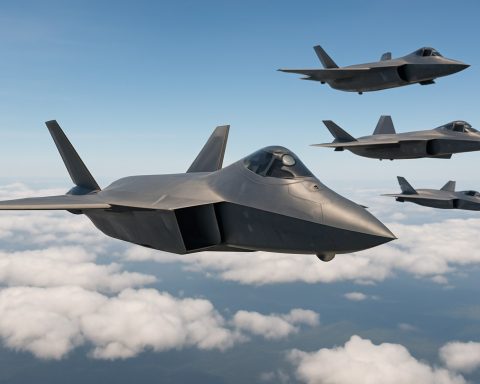- The US Air Force successfully revived an F-35 fighter jet, dubbed “Frankenjet,” demonstrating innovation and cost-effectiveness.
- Two damaged aircraft, AF-27 and AF-211, were combined to create a single, functional fighter, showcasing engineering ingenuity.
- This effort saved $63 million in taxpayer money compared to purchasing a new aircraft.
- The “Frankenjet” is now part of the 338th Fighter Wing, proving its performance in flight.
- This initiative underscores the potential for resourcefulness and application in military engineering and other fields.
- The story highlights the value in reconsidering what is possible with seemingly obsolete technology.
Defying the odds, the US Air Force successfully resurrects a stealth fighter in a feat that is equal parts innovative and cost-effective. The unlikely protagonist of this tale—the so-called “Frankenjet”—stands as a testament to human ingenuity and engineering prowess.
Imagine two magnificent F-35 Lightning IIs, once hailed as cutting-edge marvels of aerial combat, now fractured and forlorn after tragic mishaps. One, known as AF-27, met its abrupt fate in 2014 as devastating engine failure set the aircraft ablaze shortly before a training mission at Eglin Air Force Base, Florida. Engine rotor fragments violently shredded vital components, eventually scorching the fighter’s rear in an inferno. Meanwhile, in June 2020, another juggernaut, AF-211, suffered a compromised nose landing gear at Hill Air Force Base, Utah, ending its journey in utter wreckage.
Typically, these incidents would consign these multimillion-dollar machines to the annals of lost causes. But rather than abandon the remnants to the scrapyard, a vision took shape—a vision that conjured life from chaos. Collaborating with Lockheed Martin, the Air Force embarked on an unprecedented journey, transcending conventional barriers. Could the nose of AF-27 intertwine with the rear of AF-211 to forge a singular combat-ready entity? The accomplished hands of engineers, armed with newly devised tools and fixtures, declared a daring “yes.”
Hill Air Force Base morphed into a scene of bustling innovation. Months transformed into years, time measured not in minutes, but in mechanics and ambition, as the team meticulously reassembled the aircraft into an unprecedented union. “Frankenjet” soared for the first time in January, unfurling its wings from Hill AFB towards the cradle of its rebirth at Lockheed Martin’s Fort Worth facility in Texas. It flew with an agility that belied its patched profile, pushing the boundaries of what is possible, as commanders marveled at its maiden performance.
The financial logic grounding this glorious endeavor is indisputable. A whopping $63 million was salvaged from taxpayer expenses by refurbishing instead of outright purchasing a new aircraft. “Frankenjet” now graces the skies, a valuable addition to the 338th Fighter Wing’s arsenal.
This tale of resurrection not only amplifies the versatility embedded within military engineering, but it prompts us to reconsider the potential of what we might view as lost. The striking narrative of the “Frankenjet” illustrates a remarkable intersection of resourcefulness and application, setting a precedent not only within the armed forces but in countless other realms of technology and restoration. In a world often quick to discard, let it remind us of the dormant potentials lying within the fragments of the seemingly obsolete.
Reviving the “Frankenjet”: How the US Air Force Saved Millions with Ingenious Engineering
The Art of Engineering: How Two Broken F-35s Became One
The story of the “Frankenjet” is a shining example of innovation and efficiency in military engineering. The collaboration between the US Air Force and Lockheed Martin showcases the profound impact of creative problem-solving on resource management—saving an impressive $63 million by refurbishing a jet instead of purchasing a new one.
Understanding Frankenjet’s Transformation
1. Combining Forces: The two F-35s involved in this remarkable feat underwent a meticulous transformation. The nose section of AF-27, which survived a catastrophic engine fire, was integrated with the aft section of AF-211, which suffered landing gear damage. Crafting a fully functional aircraft out of damaged components required cutting-edge engineering and collaboration.
2. Engineering Mastery: Achieving this required custom tools and fixtures, enabling the seamless integration of parts never meant to be paired. The level of expertise demanded from technicians was considerable, as they needed to ensure not only structural integrity but also the jet’s functionality and safety.
3. Flight Tests and Deployment: After its initial tests in January, the “Frankenjet” demonstrated impressive agility despite its composite structure, immediately becoming a part of the 338th Fighter Wing’s arsenal.
Life Hacks and Real-World Use Cases
– Military Readiness: The “Frankenjet” is a pivotal case showing how damaged or decommissioned military hardware can be repurposed, bolstering readiness without the high costs of new equipment.
– Beyond Military: This project sets a precedent for other sectors dealing with expensive machinery, such as aerospace and marine industries. Similar refurbishment initiatives can extend the life of costly machines across domains.
Industry Trends and Implications
– Sustainability in Engineering: As military organizations face tighter budgets, repurposing technology will become increasingly common. This shift aligns with broader sustainability efforts across industries, aiming to minimize waste and extend asset life.
– Rising Costs vs. Innovative Solutions: With the rising costs of developing new military technology, efforts similar to the “Frankenjet” refurbishment will likely become more prevalent.
Prospects and Predictions
– Implementing Practices: We may see the military adopting similar strategies for other complex machinery, influencing logistics and operational planning at a large scale.
– Increasing Collaborations: Partnerships with private industries like Lockheed Martin are likely to increase, allowing for novel solutions that leverage the expertise of industry leaders.
Actionable Insights
– Adopt a Creative Mindset: Businesses can benefit from viewing damaged or obsolete equipment as opportunities, not liabilities, fostering a culture of creativity in problem-solving.
– Increase Cross-Disciplinary Collaborations: Encourage working across different fields and industries, just as the Air Force collaborated with Lockheed Martin, to solve complex challenges efficiently.
For more information on the latest developments in aerospace technology, visit Lockheed Martin.
The tale of the “Frankenjet” is an inspiring reminder of the potential lying dormant in what may initially appear to be lost causes—a valuable lesson for both the military and the world.







